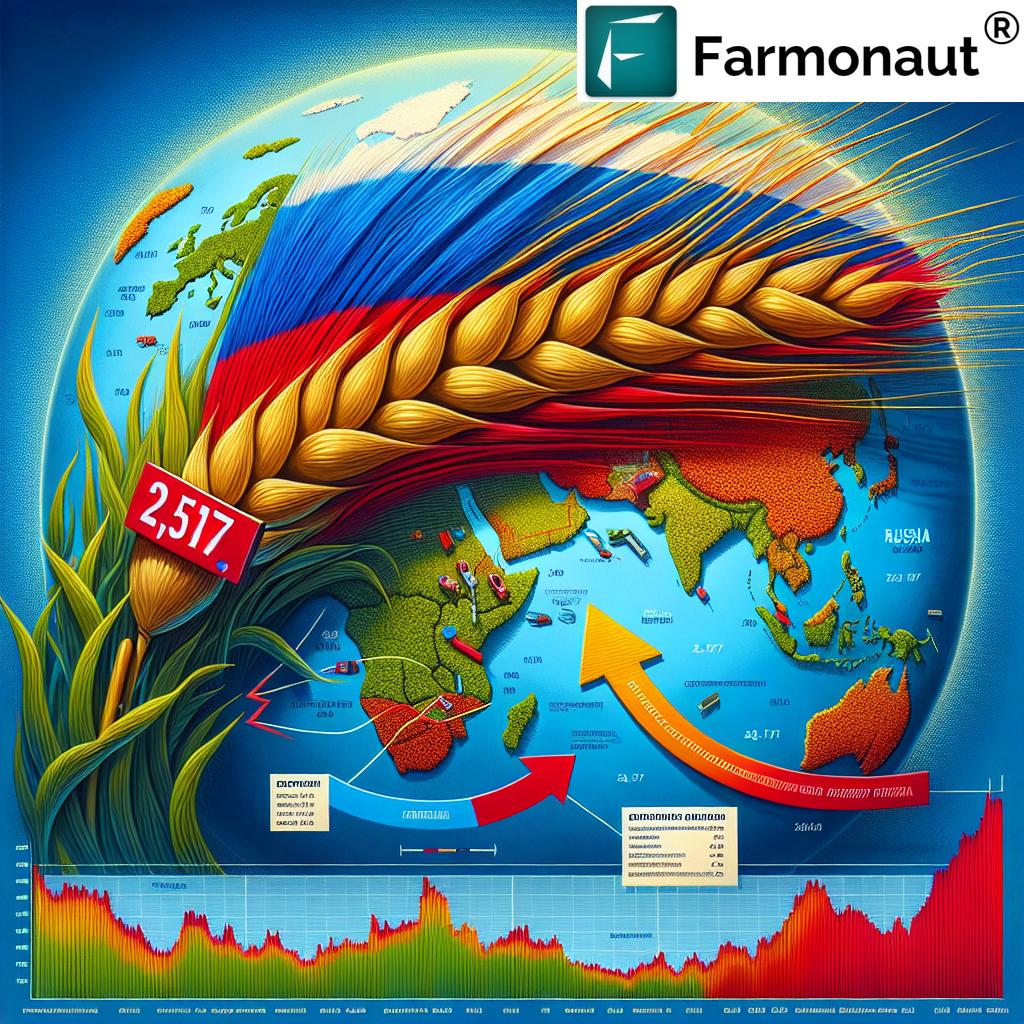Shocking Twist: Russian Wheat Export Duty Skyrockets to 2,517 Rubles, Shaking Global Grain Markets
MOSCOW, November 2, 2024 – In a startling development that has sent ripples through the international grain trade, the Russian Ministry of Agriculture has announced a dramatic increase in the Russian wheat export duty to 2,517 rubles ($25.72) per metric ton, effective from November 7, 2024. This unexpected surge in grain export tariffs is poised to have far-reaching consequences on agricultural commodity prices and the global grain market landscape.

Comprehensive Overview of the New Export Duties
The Russian grain export regulations have undergone significant changes, affecting not only wheat but other key grains as well:
- Wheat Export Duty: 2,517 rubles ($25.72) per metric ton
- Barley Export Duty: 1,266.2 rubles ($12.94) per metric ton
- Corn Export Duty: 3,059.9 rubles ($31.39) per metric ton
These new tariffs are calculated based on indicative prices set by the Ministry:
- Wheat and meslin: $222.5 per metric ton
- Barley: $192.5 per metric ton
- Corn: $218.9 per metric ton
The implementation of these Russian wheat export tariffs 2024 is scheduled to remain in effect until November 12, potentially causing significant agricultural commodity price changes in the short term.
The Floating Duty System: A Closer Look
The floating duty system Russia has implemented for grain exports has been in place since June 2, 2021. This system, designed to regulate the Russian grain market, operates on a weekly basis. The Ministry of Agriculture calculates and publishes the duty rates every week on their official website.
A significant change occurred on July 1, 2022, when the duty calculations transitioned from U.S. dollars to rubles. The current system sets the duty at 70% of the difference between the base price and the indicative price, a mechanism aimed at balancing domestic needs with export demands.
For those interested in tracking these changes in real-time, Farmonaut offers comprehensive satellite and weather data through their API. Developers can access detailed documentation at the API Developer Docs.
Global Grain Market Impact: A Ripple Effect
The Russian wheat export duty increase is expected to have significant international grain trade effects. As one of the world’s largest wheat exporters, Russia’s policy changes can dramatically shift global supply dynamics.
- Price Volatility: Immediate price spikes in wheat futures markets are anticipated.
- Supply Chain Disruptions: Importers may need to seek alternative sources, potentially straining other exporting countries.
- Food Security Concerns: Higher wheat prices could impact food security in import-dependent nations.

To stay updated on these market changes, consider using Farmonaut’s mobile app:
Implications for Russian Farmers and the Domestic Market
The increased export duties present a double-edged sword for Russian agricultural stakeholders:
- Potential Income Reduction: Higher duties may lead to lower export volumes, potentially reducing farmers’ incomes.
- Domestic Price Stabilization: The measures aim to ensure adequate domestic supply and prevent excessive local price increases.
- Long-term Market Positioning: There are concerns about Russia’s competitive position in the global wheat market if high duties persist.
Farmers and agribusinesses can leverage Farmonaut’s web application for better crop management and market analysis:
The Broader Context: Geopolitical and Economic Factors
The drastic increase in Russian wheat export duty doesn’t occur in isolation. Several factors contribute to this policy shift:
- Global Food Security: Increasing concerns about food security in the wake of climate change and geopolitical tensions.
- Economic Sanctions: The ongoing impact of international sanctions on Russia’s economy may influence agricultural policy decisions.
- Currency Fluctuations: The shift to ruble-based calculations reflects efforts to stabilize the domestic currency.
- Climate Variability: Changing weather patterns affecting crop yields globally, influencing export strategies.
International Reactions and Market Adaptations
The global grain market impact of Russia’s decision is already eliciting responses from various quarters:
- Competing Exporters: Countries like the United States, Canada, and Australia may see increased demand for their wheat exports.
- Import-Dependent Nations: Countries heavily reliant on Russian wheat are likely to diversify their import sources.
- International Organizations: Bodies like the FAO may need to reassess global food security projections.
For real-time updates on these global market shifts, Farmonaut’s satellite-based crop monitoring can provide valuable insights:
Access Farmonaut’s Web Application
Looking Ahead: Potential Scenarios and Market Predictions
As the international grain trade adjusts to these new realities, several scenarios could unfold:
- Short-term Price Volatility: Expect significant fluctuations in wheat prices over the coming weeks.
- Shift in Trade Patterns: New trade relationships may form as importers seek alternatives to Russian wheat.
- Policy Adjustments: Other major exporters might revise their agricultural policies in response.
- Technological Adaptation: Increased focus on agricultural technology to boost productivity and reduce reliance on imports.
Conclusion: A New Era in Global Grain Trade
The dramatic increase in Russian wheat export duty to 2,517 rubles marks a significant moment in the international grain trade. As markets adapt to these new Russian grain export regulations, the ripple effects will be felt across the global agricultural landscape. Stakeholders at all levels of the supply chain must remain vigilant and adaptable in the face of these changes.
For those seeking to navigate these turbulent waters, tools like Farmonaut’s satellite-based crop monitoring and market analysis can provide crucial insights. Stay informed and make data-driven decisions in this evolving agricultural landscape.
Stay updated with the latest in agricultural technology and market trends:
As the situation continues to evolve, keeping a close eye on agricultural commodity prices and wheat export regulations will be crucial for all players in the global grain market. The coming months will undoubtedly bring further developments in this critical sector of the world economy.















